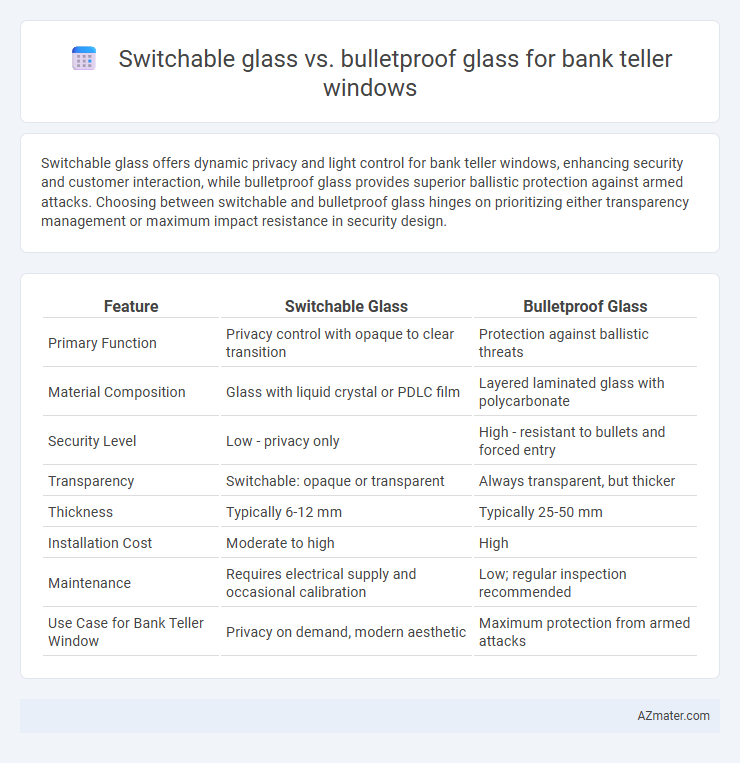Switchable glass offers dynamic privacy and light control for bank teller windows, enhancing security and customer interaction, while bulletproof glass provides superior ballistic protection against armed attacks. Choosing between switchable and bulletproof glass hinges on prioritizing either transparency management or maximum impact resistance in security design.
Table of Comparison
| Feature | Switchable Glass | Bulletproof Glass |
|---|---|---|
| Primary Function | Privacy control with opaque to clear transition | Protection against ballistic threats |
| Material Composition | Glass with liquid crystal or PDLC film | Layered laminated glass with polycarbonate |
| Security Level | Low - privacy only | High - resistant to bullets and forced entry |
| Transparency | Switchable: opaque or transparent | Always transparent, but thicker |
| Thickness | Typically 6-12 mm | Typically 25-50 mm |
| Installation Cost | Moderate to high | High |
| Maintenance | Requires electrical supply and occasional calibration | Low; regular inspection recommended |
| Use Case for Bank Teller Window | Privacy on demand, modern aesthetic | Maximum protection from armed attacks |
Introduction to Bank Teller Window Security
Bank teller window security relies heavily on the quality and functionality of protective glass, where switchable glass offers privacy and light control through electronically adjustable opacity while maintaining clear visibility when needed. Bulletproof glass, rated typically from UL 752 Level 3 to Level 8, provides robust ballistic protection designed to withstand gunfire and physical attacks, ensuring maximum safety against armed threats. Selecting between switchable and bulletproof glass depends on balancing security requirements with operational needs, where bulletproof glass prioritizes defense and switchable glass enhances customer interaction and confidentiality.
Overview of Switchable Glass Technology
Switchable glass technology uses electrochromic or polymer dispersed liquid crystal (PDLC) films to change from transparent to opaque instantly, enhancing privacy and security in bank teller windows. This glass offers dynamic control over visibility without compromising natural light, making it ideal for customer interaction zones requiring both discretion and openness. Unlike bulletproof glass, which prioritizes physical protection, switchable glass focuses on visual privacy and aesthetic flexibility while maintaining safety standards.
Bulletproof Glass: Composition and Capabilities
Bulletproof glass for bank teller windows is typically composed of multiple layers of laminated polycarbonate and glass, designed to absorb and disperse impact energy from bullets and other projectiles. Its capabilities include resistance to various calibers of firearms, preventing penetration and providing enhanced security for employees and customers. High-grade bulletproof glass often meets stringent safety standards such as UL 752 or NIJ Level III, ensuring reliability in high-risk environments.
Security Features: Switchable vs Bulletproof Glass
Switchable glass enhances security at bank teller windows by providing privacy and preventing visibility during high-risk situations, effectively deterring potential threats through instant opacity control. Bulletproof glass offers robust physical protection with multiple laminated layers designed to resist firearm penetration, ensuring safety against armed attacks. While switchable glass improves situational control and secrecy, bulletproof glass delivers unmatched ballistic resistance essential for safeguarding personnel against direct violent assaults.
Privacy and Confidentiality Concerns in Banks
Switchable glass offers dynamic privacy control for bank teller windows, enabling instant opacity to protect sensitive client information during transactions, enhancing confidentiality without sacrificing natural light. Bulletproof glass provides robust physical security but lacks the ability to obscure visibility, potentially exposing confidential interactions to onlookers. Combining switchable glass technology with bulletproof materials creates an optimal solution for banks, balancing privacy, confidentiality, and security requirements.
Durability and Maintenance Comparison
Switchable glass offers moderate durability with a lifespan of 10-15 years, requiring regular maintenance to preserve its electronic components and surface integrity. Bulletproof glass provides superior durability, designed to withstand high-impact ballistic forces and resist scratching, with minimal maintenance needed beyond routine cleaning. For bank teller windows, bulletproof glass ensures maximum protection and longevity, while switchable glass demands more upkeep but adds privacy control features.
Cost Analysis: Initial Investment and Long-Term Value
Switchable glass initially costs more than standard bulletproof glass due to integrated technology enabling privacy control, but it offers energy savings and improved operational efficiency over time. Bulletproof glass requires higher upfront investment for quality materials to meet security standards, with long-term value tied to its durability and low maintenance needs. Evaluating total cost of ownership, switchable glass provides multifunctional benefits, while bulletproof glass ensures essential protection with predictable expenses.
Installation Challenges and Requirements
Switchable glass requires precise electrical wiring and integration with the building's control system, which can complicate installation at a bank teller window, demanding skilled electricians and adherence to strict safety codes. Bulletproof glass installation involves heavy, reinforced framing to support its weight and thickness, often necessitating structural modifications to the teller window setup to maintain security standards. Both glass types require compliance with fire safety regulations and compatibility with existing window dimensions, posing unique challenges in balancing security, functionality, and customer interaction.
Aesthetics and Design Flexibility
Switchable glass offers superior aesthetics and design flexibility for bank teller windows by seamlessly transitioning from transparent to opaque, allowing for privacy without compromising modern visual appeal. Bulletproof glass, while essential for security, tends to be thicker and less versatile in design, often limiting creative architectural integration and sleekness. Therefore, switchable glass enhances customer experience with dynamic control over light and visibility, whereas bulletproof glass prioritizes maximum protection with more rigid aesthetic options.
Choosing the Right Glass for Bank Teller Windows
Choosing the right glass for bank teller windows involves balancing security with customer interaction. Switchable glass enables privacy and glare control by transitioning from transparent to opaque, enhancing comfort and discretion without compromising visibility during transactions. Bulletproof glass offers superior protection against forced entry and ballistic threats, making it essential for high-risk environments where maximum security is a priority.

Infographic: Switchable glass vs Bulletproof glass for Bank teller window
 azmater.com
azmater.com